
Can anyone help with info on this great find ??
sparky99, Mon Jul 12 2010, 12:45AMHi All,
Was at a Hamfest in Sussex, NJ today and found a Jennings J 1003 high voltage voltmeter at a price I couldn't pass up. Just looks alone was well worth the price! I had 4 offers to buy it, one for 8 times what I paid for it, but turned them down. I sure would like to have a manual for it, but there is little online.
Anyone have any info on this gem. A search of Jennings website turns up nothing.
Thanks,
bob
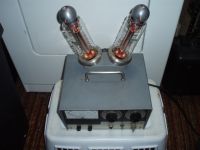
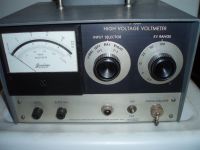
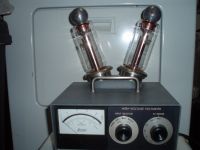
Re: Can anyone help with info on this great find ??
radiotech, Mon Jul 12 2010, 02:49AM
Try here

It looks like a nice pre-digital meter for testing the things Jennings makes
radiotech, Mon Jul 12 2010, 02:49AM
Try here

It looks like a nice pre-digital meter for testing the things Jennings makes
Re: Can anyone help with info on this great find ??
Patrick, Mon Jul 12 2010, 04:47AM
how does that thing work?
Patrick, Mon Jul 12 2010, 04:47AM
how does that thing work?
Re: Can anyone help with info on this great find ??
Herr Zapp, Mon Jul 12 2010, 06:20AM
Sparky -
Nice find ....... it's a Jennings Technology J-1000 capacitive voltage divider. I believe the ratio is 1,000:1.
Take care to protect the glass vacuum capacitors; if I remember correctly they just plug in to the housing from the top. I'd keep the capacitors in separate well-protected packaging except when actually using the instrument.
These dividers show up on eBay from time to time, frequently missing one (or both) of the capacitors.
Regards,
Herr Zapp
Herr Zapp, Mon Jul 12 2010, 06:20AM
Sparky -
Nice find ....... it's a Jennings Technology J-1000 capacitive voltage divider. I believe the ratio is 1,000:1.
Take care to protect the glass vacuum capacitors; if I remember correctly they just plug in to the housing from the top. I'd keep the capacitors in separate well-protected packaging except when actually using the instrument.
These dividers show up on eBay from time to time, frequently missing one (or both) of the capacitors.
Regards,
Herr Zapp
Re: Can anyone help with info on this great find ??
Patrick, Mon Jul 12 2010, 09:13AM
did i see on the pic a 100kv range?!
you wanna sell it to me?
does it have a frequency capability? or is it just a near DC affair?
Patrick, Mon Jul 12 2010, 09:13AM
did i see on the pic a 100kv range?!
you wanna sell it to me?
does it have a frequency capability? or is it just a near DC affair?
Re: Can anyone help with info on this great find ??
IntraWinding, Mon Jul 12 2010, 11:11AM
What a great meter! I'm envious!
I'm under the impression that a vacuum capacitor operated at 100KV would be an X-Ray hazard, but the meter design seems to suggest the manufacturer didn't see this as a concern.
Either that or the manual warns you to only read the meter from a good distance with binoculars!
So does anyone know the truth about vacuum capacitors and X-Rays?
IntraWinding, Mon Jul 12 2010, 11:11AM
What a great meter! I'm envious!
I'm under the impression that a vacuum capacitor operated at 100KV would be an X-Ray hazard, but the meter design seems to suggest the manufacturer didn't see this as a concern.
Either that or the manual warns you to only read the meter from a good distance with binoculars!

So does anyone know the truth about vacuum capacitors and X-Rays?
Re: Can anyone help with info on this great find ??
Proud Mary, Mon Jul 12 2010, 01:25PM
The Jennings instrument is an antique, and dates to a period of minimalist radiological protection standards.
Any vacuum capacitor with a pd across it sufficient to produce electron field emission tunneling will generate X-rays - but only when ~10-15kV is applied will these
X-ray photons have sufficient energy to transit the glass envelope.
There is no fundamental difference between a cold cathode X-ray tube and a vacuum capacitor, except the geometry of the electrodes.
Proud Mary, Mon Jul 12 2010, 01:25PM
IntraWinding wrote ...
What a great meter! I'm envious!
I'm under the impression that a vacuum capacitor operated at 100KV would be an X-Ray hazard, but the meter design seems to suggest the manufacturer didn't see this as a concern.
Either that or the manual warns you to only read the meter from a good distance with binoculars!
So does anyone know the truth about vacuum capacitors and X-Rays?
What a great meter! I'm envious!
I'm under the impression that a vacuum capacitor operated at 100KV would be an X-Ray hazard, but the meter design seems to suggest the manufacturer didn't see this as a concern.
Either that or the manual warns you to only read the meter from a good distance with binoculars!

So does anyone know the truth about vacuum capacitors and X-Rays?
The Jennings instrument is an antique, and dates to a period of minimalist radiological protection standards.
Any vacuum capacitor with a pd across it sufficient to produce electron field emission tunneling will generate X-rays - but only when ~10-15kV is applied will these
X-ray photons have sufficient energy to transit the glass envelope.
There is no fundamental difference between a cold cathode X-ray tube and a vacuum capacitor, except the geometry of the electrodes.
Re: Can anyone help with info on this great find ??
IntraWinding, Mon Jul 12 2010, 02:21PM
sparky99:
OK, so you need to be aware of an X-Ray hazard when this meter is used!
Proud Mary:
I'm wondering about ways to minimise the X-Ray hazard from a vacuum capacitor.
Clearly having one electrode physically located within the other allows the outer electrode material to act as an X-Ray shield.
On that basis a more substantial outer electrode made of a more X-Ray opaque material would be advantageous.
Are some electrode materials less efficient producers of the more hazardous X-Rays.
Would larger radius electrode surfaces reduce electron emission?
What about having the electrodes coated in an insulating layer?
IntraWinding, Mon Jul 12 2010, 02:21PM
sparky99:
OK, so you need to be aware of an X-Ray hazard when this meter is used!
Proud Mary:
I'm wondering about ways to minimise the X-Ray hazard from a vacuum capacitor.
Clearly having one electrode physically located within the other allows the outer electrode material to act as an X-Ray shield.
On that basis a more substantial outer electrode made of a more X-Ray opaque material would be advantageous.
Are some electrode materials less efficient producers of the more hazardous X-Rays.
Would larger radius electrode surfaces reduce electron emission?
What about having the electrodes coated in an insulating layer?
Re: Can anyone help with info on this great find ??
Proud Mary, Mon Jul 12 2010, 02:59PM
I know very little about vacuum capacitors, but would imagine that they are subject to some of the same constraints as thermionic valves when it comes to choice of construction materials - compatible metal-to-glass seals, compatible coefficients of thermal expansion and contact potential problems between dissimilar metals, gas absorption and adsorption by the electrodes, and so on.
In thermionic valve technology, unwanted X-ray emission was often dealt with by the use of lead glass, warnings printed on the glass bulb, and hazard information in the data sheet. A good example of this was the American TV shunt stabiliser triode 6BK4. In its first two iterations, 6BK4A and 6BKB, this interesting valve came with a standard high temperature glass mix, but after the TV X-ray scare of the late 1960s, the 6BK4C became obviously heavier than its predecessors due to the use of lead glass, and it now sported a printed warning on the bulb, and in the data sheet. The manufacturers did not see lead glass alone as sufficient to attenuate the X-rays, so the user was advised to operate the valve inside a metal enclosure to reduce the domestic viewer's justified paranoia to non-litigious proportions.
TV thermionic EHT rectifiers could also become a hazardous source of X-rays when their heaters failed. In normal operation, the forward voltage drop across the valve would be a few hundred volts, but when the heater failed, the PD across the valve would jump to 30kV or so, making it a potent source of X-rays.
Today, vacuum capacitors have few applications outside of high power transmitters, whose designers could be expected to manage the X-ray hazard as part of their overall safety brief. Unwanted X-ray production is not confined to vacuum capacitors, but is always a problem to be worked around with high power RF amplifier valves having tens of kV of anode voltage.
See:
X-ray emission from broadcast transmitters
Hunter, E.B.
Voice of America, Greenville, NC
This paper appears in: Broadcasting, IEEE Transactions on
Issue Date: Mar 1990
Volume: 36 Issue: 1
On page(s): 14 - 23
ISSN: 0018-9316
INSPEC Accession Number: 3689360
Digital Object Identifier: 10.1109/11.52360
Date of Current Version: 06 August 2002
ABSTRACT
During the past few years amplitude-modulated transmitters employing efficient pulse-width modulators have come into common use. These transmitters are reliable, relatively insensitive to vacuum tube characteristics, and offer excellent audio fidelity. Their architecture requires, however, supply voltages in the 20-30-kV range, which greatly enhances the production of ionizing radiation in the form of X-rays. Recent analysis by Voice of America indicates that these X-rays are being emitted in short, high-intensity bursts focused into broad radial beams. The general aspects of ionizing radiation of interest to communications engineers are reviewed. The spectral and time-domain characteristics of X-ray radiation from transmitters are examined, a method for estimating fault-condition radiation values is suggested, and the findings of the Voice of America are discussed
Proud Mary, Mon Jul 12 2010, 02:59PM
IntraWinding wrote ...
[Proud Mary:
I'm wondering about ways to minimise the X-Ray hazard from a vacuum capacitor.
Clearly having one electrode physically located within the other allows the outer electrode material to act as an X-Ray shield.
On that basis a more substantial outer electrode made of a more X-Ray opaque material would be advantageous.
Are some electrode materials less efficient producers of the more hazardous X-Rays.
Would larger radius electrode surfaces reduce electron emission?
What about having the electrodes coated in an insulating layer?
[Proud Mary:
I'm wondering about ways to minimise the X-Ray hazard from a vacuum capacitor.
Clearly having one electrode physically located within the other allows the outer electrode material to act as an X-Ray shield.
On that basis a more substantial outer electrode made of a more X-Ray opaque material would be advantageous.
Are some electrode materials less efficient producers of the more hazardous X-Rays.
Would larger radius electrode surfaces reduce electron emission?
What about having the electrodes coated in an insulating layer?
I know very little about vacuum capacitors, but would imagine that they are subject to some of the same constraints as thermionic valves when it comes to choice of construction materials - compatible metal-to-glass seals, compatible coefficients of thermal expansion and contact potential problems between dissimilar metals, gas absorption and adsorption by the electrodes, and so on.
In thermionic valve technology, unwanted X-ray emission was often dealt with by the use of lead glass, warnings printed on the glass bulb, and hazard information in the data sheet. A good example of this was the American TV shunt stabiliser triode 6BK4. In its first two iterations, 6BK4A and 6BKB, this interesting valve came with a standard high temperature glass mix, but after the TV X-ray scare of the late 1960s, the 6BK4C became obviously heavier than its predecessors due to the use of lead glass, and it now sported a printed warning on the bulb, and in the data sheet. The manufacturers did not see lead glass alone as sufficient to attenuate the X-rays, so the user was advised to operate the valve inside a metal enclosure to reduce the domestic viewer's justified paranoia to non-litigious proportions.
TV thermionic EHT rectifiers could also become a hazardous source of X-rays when their heaters failed. In normal operation, the forward voltage drop across the valve would be a few hundred volts, but when the heater failed, the PD across the valve would jump to 30kV or so, making it a potent source of X-rays.
Today, vacuum capacitors have few applications outside of high power transmitters, whose designers could be expected to manage the X-ray hazard as part of their overall safety brief. Unwanted X-ray production is not confined to vacuum capacitors, but is always a problem to be worked around with high power RF amplifier valves having tens of kV of anode voltage.
See:
X-ray emission from broadcast transmitters
Hunter, E.B.
Voice of America, Greenville, NC
This paper appears in: Broadcasting, IEEE Transactions on
Issue Date: Mar 1990
Volume: 36 Issue: 1
On page(s): 14 - 23
ISSN: 0018-9316
INSPEC Accession Number: 3689360
Digital Object Identifier: 10.1109/11.52360
Date of Current Version: 06 August 2002
ABSTRACT
During the past few years amplitude-modulated transmitters employing efficient pulse-width modulators have come into common use. These transmitters are reliable, relatively insensitive to vacuum tube characteristics, and offer excellent audio fidelity. Their architecture requires, however, supply voltages in the 20-30-kV range, which greatly enhances the production of ionizing radiation in the form of X-rays. Recent analysis by Voice of America indicates that these X-rays are being emitted in short, high-intensity bursts focused into broad radial beams. The general aspects of ionizing radiation of interest to communications engineers are reviewed. The spectral and time-domain characteristics of X-ray radiation from transmitters are examined, a method for estimating fault-condition radiation values is suggested, and the findings of the Voice of America are discussed
Re: Can anyone help with info on this great find ??
quicksilver, Mon Jul 12 2010, 07:32PM
Perhaps it would be advisable to build a cover of some transparent type to both protect you and the tubes....?
quicksilver, Mon Jul 12 2010, 07:32PM
Perhaps it would be advisable to build a cover of some transparent type to both protect you and the tubes....?
Re: Can anyone help with info on this great find ??
Patrick, Mon Jul 12 2010, 08:20PM
Patrick, Mon Jul 12 2010, 08:20PM
Proud Mary wrote ...
The Jennings instrument is an antique, and dates to a period of minimalist radiological protection standards.
thats a good point Proud mary, back in the 50's/60's radiation was the new "it" thing. radioactive food and "energy drinks" ( which caused one mans lower jaw to fall off ), and nuclear weapons used for civil construction pojects like roads and dams. the relative safety was just presumed to be acceptable, but i think now that has been disproven with the nevada/utah downwinders in america and the Semipalatinsk Polygon downwinders of the soviet era.The Jennings instrument is an antique, and dates to a period of minimalist radiological protection standards.
Re: Can anyone help with info on this great find ??
Adam Munich, Mon Jul 12 2010, 08:31PM
How about making cardboard tubes that fit around the caps, then wrap a layer of lead sheet around the tubes. If you ever need to measure anything 15kv+, then just slide on the cap tubes.
Adam Munich, Mon Jul 12 2010, 08:31PM
How about making cardboard tubes that fit around the caps, then wrap a layer of lead sheet around the tubes. If you ever need to measure anything 15kv+, then just slide on the cap tubes.
Re: Can anyone help with info on this great find ??
IntraWinding, Tue Jul 13 2010, 10:09AM
I think the way to go is to get/make an X-Ray measuring device so you can see if there is a hazard when you use it.
You'll then also be able to see if you've solved it!
IntraWinding, Tue Jul 13 2010, 10:09AM
I think the way to go is to get/make an X-Ray measuring device so you can see if there is a hazard when you use it.
You'll then also be able to see if you've solved it!
Re: Can anyone help with info on this great find ??
Patrick, Tue Jul 13 2010, 09:56PM
a scintillator would do nicely, to prevent harmful/fatal exposure.
Patrick, Tue Jul 13 2010, 09:56PM
a scintillator would do nicely, to prevent harmful/fatal exposure.
Re: Can anyone help with info on this great find ??
Adam Munich, Tue Jul 13 2010, 10:19PM
Doubt he wants to spend any money on a detector though.
Adam Munich, Tue Jul 13 2010, 10:19PM
Doubt he wants to spend any money on a detector though.
Re: Can anyone help with info on this great find ??
plazmatron, Tue Jul 13 2010, 11:35PM
It is unlikely that in normal operation, that the vacuum capacitors on the meter should produce any detectable x-rays.
Purposely designed cold cathode x-ray tubes are finicky at best, and will only operate in a certain pressure range (yes they contain gas). If the pressure drops too far, x-ray emission will cease.
A vacuum capacitor should have a hard vacuum, and whilst the vacuum can break down, and conduct, it should only be transient. Vacuum breakdown is poorly understood, however it is sometimes deliberately induced during processing of high voltage tubes, in order to smooth off any microscopic projections off of otherwise smooth electrodes (a process known as "spot knocking").
If the vacuum were to go "soft", a detectable amount of x-rays may be produced, but then, the meter wouldn't work either.
If you are really concerned, you could use thick chlorinated perspex sleeves over those caps. But personally I wouldn't be sitting for any length of time with my face up to a meter that has 100kV exposed terminals on top!
Les
plazmatron, Tue Jul 13 2010, 11:35PM
It is unlikely that in normal operation, that the vacuum capacitors on the meter should produce any detectable x-rays.
Purposely designed cold cathode x-ray tubes are finicky at best, and will only operate in a certain pressure range (yes they contain gas). If the pressure drops too far, x-ray emission will cease.
A vacuum capacitor should have a hard vacuum, and whilst the vacuum can break down, and conduct, it should only be transient. Vacuum breakdown is poorly understood, however it is sometimes deliberately induced during processing of high voltage tubes, in order to smooth off any microscopic projections off of otherwise smooth electrodes (a process known as "spot knocking").
If the vacuum were to go "soft", a detectable amount of x-rays may be produced, but then, the meter wouldn't work either.
If you are really concerned, you could use thick chlorinated perspex sleeves over those caps. But personally I wouldn't be sitting for any length of time with my face up to a meter that has 100kV exposed terminals on top!

Les
Re: Can anyone help with info on this great find ??
teravolt, Wed Jul 14 2010, 02:54AM
I believe that is a capacitive voltage divider with a diferensioal input for measuring peak HV up to 50kv. The unit will not emit x-rays. The nice thing about it is that it has a scope port and if you have a DRSSTC around and it has the frequency response then you can see the tank voltage across L or C or use the meter to tune it by looking for the largest VCpeak or VLpeak
teravolt, Wed Jul 14 2010, 02:54AM
I believe that is a capacitive voltage divider with a diferensioal input for measuring peak HV up to 50kv. The unit will not emit x-rays. The nice thing about it is that it has a scope port and if you have a DRSSTC around and it has the frequency response then you can see the tank voltage across L or C or use the meter to tune it by looking for the largest VCpeak or VLpeak
Re: Can anyone help with info on this great find ??
Bored Chemist, Wed Jul 14 2010, 06:39PM
Surely a capacitor that leaks (significant numbers of) electrons isn't a capacitor?
If it leaked enough to produce any decent current it wouldn't work. If it doesn't draw a current then it can't generate Xrays.
Bored Chemist, Wed Jul 14 2010, 06:39PM
Surely a capacitor that leaks (significant numbers of) electrons isn't a capacitor?
If it leaked enough to produce any decent current it wouldn't work. If it doesn't draw a current then it can't generate Xrays.
Re: Can anyone help with info on this great find ??
radiotech, Wed Jul 14 2010, 09:28PM
The meter measures the charging current flowing from the high side of one vacuum capacitor though an impedance to the low side of the other vacuum capacitor. The voltage across the impedance is scaled for the meter range selected.
Not wishing to start a debate, x-rays require kinetic energy as Bored Chemist stated. If the input vacuum capacitors had any power factor, some of that energy loss might produce x-rays .
radiotech, Wed Jul 14 2010, 09:28PM
The meter measures the charging current flowing from the high side of one vacuum capacitor though an impedance to the low side of the other vacuum capacitor. The voltage across the impedance is scaled for the meter range selected.
Not wishing to start a debate, x-rays require kinetic energy as Bored Chemist stated. If the input vacuum capacitors had any power factor, some of that energy loss might produce x-rays .
Re: Can anyone help with info on this great find ??
Proud Mary, Wed Jul 14 2010, 10:46PM
I'm sure you must be having a joke with us here?
Looking at Comet AG's
SERVICE BULLETIN SB-52
Technical Recommendations and General
Instructions for Vacuum Capacitors
we read:
Combined DC plus RF, or DC blocking applications, present a particular problem for
vacuum capacitors because of the field emission current.
COMET however has pioneered manufacturing processes that reduce field emission,
as well as total leakage current of conventional capacitors for DC applications to less
than 0.1 μA, a level which is significantly lower than what is generally accepted for
regular RF applications. The standard leakage current is as follows:
Capacitor type DC leakage current
at peak working voltage (Upw)
Fixed vacuum capacitors < 1 μA
Variable vacuum capacitors £ 15 kV < 10 μA
Variable vacuum capacitors > 15 kV < 1 μA
In praxis DC leakage current as low as 0.1 μA is frequently achieved.
To achieve excellent operating performance COMET recommends that the combined
DC plus RF peak working voltage should not exceed the rated peak working voltage.
As a good engineering practice the DC voltage should not exceed 25% or better yet
20% of peak test voltage.
But this is from a top of the range, brand new Swiss vacuum capacitor specially designed for low field emission @ just 15kV in the year 2010.
If we are extremely conservative, and assume that the elderly vacuum capacitors in
this Jennings meter draw as little as 10uA field emission current at 100kV, then we would have about
2.5 Gy/hr at a distance of 10cm from the tube, a non trivial quantity.
But you guys know what beliefs work best for you, so I'll leave you to it!
Proud Mary, Wed Jul 14 2010, 10:46PM
Bored Chemist wrote ...
Surely a capacitor that leaks (significant numbers of) electrons isn't a capacitor?
If it leaked enough to produce any decent current it wouldn't work. If it doesn't draw a current then it can't generate Xrays.
Surely a capacitor that leaks (significant numbers of) electrons isn't a capacitor?
If it leaked enough to produce any decent current it wouldn't work. If it doesn't draw a current then it can't generate Xrays.
I'm sure you must be having a joke with us here?

Looking at Comet AG's
SERVICE BULLETIN SB-52
Technical Recommendations and General
Instructions for Vacuum Capacitors
we read:
Combined DC plus RF, or DC blocking applications, present a particular problem for
vacuum capacitors because of the field emission current.
COMET however has pioneered manufacturing processes that reduce field emission,
as well as total leakage current of conventional capacitors for DC applications to less
than 0.1 μA, a level which is significantly lower than what is generally accepted for
regular RF applications. The standard leakage current is as follows:
Capacitor type DC leakage current
at peak working voltage (Upw)
Fixed vacuum capacitors < 1 μA
Variable vacuum capacitors £ 15 kV < 10 μA
Variable vacuum capacitors > 15 kV < 1 μA
In praxis DC leakage current as low as 0.1 μA is frequently achieved.
To achieve excellent operating performance COMET recommends that the combined
DC plus RF peak working voltage should not exceed the rated peak working voltage.
As a good engineering practice the DC voltage should not exceed 25% or better yet
20% of peak test voltage.
But this is from a top of the range, brand new Swiss vacuum capacitor specially designed for low field emission @ just 15kV in the year 2010.
If we are extremely conservative, and assume that the elderly vacuum capacitors in
this Jennings meter draw as little as 10uA field emission current at 100kV, then we would have about
2.5 Gy/hr at a distance of 10cm from the tube, a non trivial quantity.
But you guys know what beliefs work best for you, so I'll leave you to it!

Re: Can anyone help with info on this great find ??
Adam Munich, Wed Jul 14 2010, 11:21PM
^^ That's quite alot of radiation. An hour a foot from that meter (while on) and you have a 10% chance of death.
Good luck!
Adam Munich, Wed Jul 14 2010, 11:21PM
^^ That's quite alot of radiation. An hour a foot from that meter (while on) and you have a 10% chance of death.
Good luck!
Re: Can anyone help with info on this great find ??
Patrick, Wed Jul 14 2010, 11:34PM
wholly crap!? i reiterate my previous statement: " X-rays are only fun to play with when they dont cuase death."
i think we need here the comments from an ace radiation expert, if there are a few on the forum.
and remember distance is the best defense against anything.
also, as i said previously in this thread, a scintilation counter would settle the debate with definate measurements.
Patrick, Wed Jul 14 2010, 11:34PM
Proud Mary wrote ...
If we are extremely conservative, and assume that the elderly vacuum capacitors in
this Jennings meter draw as little as 10uA field emission current at 100kV, then we would have about
2.5 Gy/hr at a distance of 10cm from the tube, a non trivial quantity.
If we are extremely conservative, and assume that the elderly vacuum capacitors in
this Jennings meter draw as little as 10uA field emission current at 100kV, then we would have about
2.5 Gy/hr at a distance of 10cm from the tube, a non trivial quantity.
wholly crap!? i reiterate my previous statement: " X-rays are only fun to play with when they dont cuase death."
i think we need here the comments from an ace radiation expert, if there are a few on the forum.
and remember distance is the best defense against anything.
also, as i said previously in this thread, a scintilation counter would settle the debate with definate measurements.
Re: Can anyone help with info on this great find ??
Proud Mary, Thu Jul 15 2010, 12:26AM
I'm not sure that exaggeration is necessarily helpful here!
At a distance of 30cm, the dose rate would be of the order of 150 mSv/hr and 13mSv/hr at one metre.
To put these figures into the perspective of the UK IONISING RADIATION REGULATIONS 1999 & RADIATION DOSE LIMITS
which came into effect on January 1st 2000
IRR99 DOSE LIMITS
To limit stochastic effects the dose limits are
1 Radiation workers >18 years:
The effective dose shall be 20 mSv in any calendar year
2 Members of the public:
The effective dose shall be 1 mSv in any calendar year
3 Trainees aged under 18 years:
The effective dose shall be 6 mSv in any calendar year
To prevent deterministic effects the limits are 1 Radiation worker >18 years:
The limit on equivalent dose for the skin, hands, forearms, feet and ankles shall be 500 mSv/year
2 Radiation worker >18 years:
The limit on equivalent dose for the lens of the eye shall be 150 mSv/year
3 Trainee aged <18 years:
The limit on equivalent dose for the lens of the eye shall be 50 mSv/year
4 Trainee aged < 18 years
The limit on equivalent dose for skin, hands, forearms, feet and ankles shall be 150 mSv / year
5 Women of reproductive capacity
The limit on equivalent dose for the abdomen shall be 13 mSv in any consecutive period of three months. Once a pregnancy has been confirmed and the employer notified, the equivalent dose to the foetus should not exceed 1 mSv during the remainder of the pregnancy.
Proud Mary, Thu Jul 15 2010, 12:26AM
Grenadier wrote ...
^^ That's quite alot of radiation. An hour a foot from that meter (while on) and you have a 10% chance of death.
^^ That's quite alot of radiation. An hour a foot from that meter (while on) and you have a 10% chance of death.
I'm not sure that exaggeration is necessarily helpful here!

At a distance of 30cm, the dose rate would be of the order of 150 mSv/hr and 13mSv/hr at one metre.
To put these figures into the perspective of the UK IONISING RADIATION REGULATIONS 1999 & RADIATION DOSE LIMITS
which came into effect on January 1st 2000
IRR99 DOSE LIMITS
To limit stochastic effects the dose limits are
1 Radiation workers >18 years:
The effective dose shall be 20 mSv in any calendar year
2 Members of the public:
The effective dose shall be 1 mSv in any calendar year
3 Trainees aged under 18 years:
The effective dose shall be 6 mSv in any calendar year
To prevent deterministic effects the limits are 1 Radiation worker >18 years:
The limit on equivalent dose for the skin, hands, forearms, feet and ankles shall be 500 mSv/year
2 Radiation worker >18 years:
The limit on equivalent dose for the lens of the eye shall be 150 mSv/year
3 Trainee aged <18 years:
The limit on equivalent dose for the lens of the eye shall be 50 mSv/year
4 Trainee aged < 18 years
The limit on equivalent dose for skin, hands, forearms, feet and ankles shall be 150 mSv / year
5 Women of reproductive capacity
The limit on equivalent dose for the abdomen shall be 13 mSv in any consecutive period of three months. Once a pregnancy has been confirmed and the employer notified, the equivalent dose to the foetus should not exceed 1 mSv during the remainder of the pregnancy.
Re: Can anyone help with info on this great find ??
IntraWinding, Thu Jul 15 2010, 12:49AM
Is that right?
IntraWinding, Thu Jul 15 2010, 12:49AM
Grenadier wrote ...
^^ That's quite alot of radiation. An hour a foot from that meter (while on) and you have a 10% chance of death.
Good luck!
^^ That's quite alot of radiation. An hour a foot from that meter (while on) and you have a 10% chance of death.
Good luck!
Is that right?
Re: Can anyone help with info on this great find ??
Patrick, Thu Jul 15 2010, 01:04AM
so you could use it for 90 mins a year, at 1 meter. And maybe not have any health effects. Ok, sparky99, try not to die.
Ok, sparky99, try not to die.
a stopwatch and scitillation couter would be useful.
Patrick, Thu Jul 15 2010, 01:04AM
Proud Mary wrote ...
At a distance of 30cm, the dose rate would be of the order of 150 mSv/hr and 13mSv/hr at one metre.To limit stochastic effects the dose limits are:
1 Radiation workers >18 years:
The effective dose shall be 20 mSv in any calendar year
At a distance of 30cm, the dose rate would be of the order of 150 mSv/hr and 13mSv/hr at one metre.To limit stochastic effects the dose limits are:
1 Radiation workers >18 years:
The effective dose shall be 20 mSv in any calendar year
so you could use it for 90 mins a year, at 1 meter. And maybe not have any health effects.
 Ok, sparky99, try not to die.
Ok, sparky99, try not to die.a stopwatch and scitillation couter would be useful.
Re: Can anyone help with info on this great find ??
Adam Munich, Thu Jul 15 2010, 01:14AM
@intrawinding No, sorry. I did the calcs again and it *could* be .17 Sv/h. That could be 7% mortality rate after 6 hours.
STILL, that may be 2mSV a minute, And 4 minutes in front of that meter would be the equivalent of one CT scan!
Also, don't forget there are TWO TUBES!
Also, does anyone find it odd that we haven't heard from sparky again...?
Adam Munich, Thu Jul 15 2010, 01:14AM
@intrawinding No, sorry. I did the calcs again and it *could* be .17 Sv/h. That could be 7% mortality rate after 6 hours.
STILL, that may be 2mSV a minute, And 4 minutes in front of that meter would be the equivalent of one CT scan!
Also, don't forget there are TWO TUBES!
Also, does anyone find it odd that we haven't heard from sparky again...?
Re: Can anyone help with info on this great find ??
Proud Mary, Thu Jul 15 2010, 01:23AM
Well, I'm sure someone will say that no harm will come from using the contraption to measure something for a minute or two, but I for one sometimes have experiments running for days on end, so without an awareness of the radiation hazard, consequences for health could follow.
Proud Mary, Thu Jul 15 2010, 01:23AM
Patrick wrote ...
so you could use it for 90 mins a year, at 1 meter. And maybe not have any health effects. Ok, sparky99, try not to die.
Ok, sparky99, try not to die.
a stopwatch and scitillation couter would be useful.
Proud Mary wrote ...
At a distance of 30cm, the dose rate would be of the order of 150 mSv/hr and 13mSv/hr at one metre.To limit stochastic effects the dose limits are:
1 Radiation workers >18 years:
The effective dose shall be 20 mSv in any calendar year
At a distance of 30cm, the dose rate would be of the order of 150 mSv/hr and 13mSv/hr at one metre.To limit stochastic effects the dose limits are:
1 Radiation workers >18 years:
The effective dose shall be 20 mSv in any calendar year
so you could use it for 90 mins a year, at 1 meter. And maybe not have any health effects.
 Ok, sparky99, try not to die.
Ok, sparky99, try not to die.a stopwatch and scitillation couter would be useful.
Well, I'm sure someone will say that no harm will come from using the contraption to measure something for a minute or two, but I for one sometimes have experiments running for days on end, so without an awareness of the radiation hazard, consequences for health could follow.
Re: Can anyone help with info on this great find ??
Adam Munich, Thu Jul 15 2010, 01:25AM
^^ i would still make the shields i described earlier though.
Adam Munich, Thu Jul 15 2010, 01:25AM
^^ i would still make the shields i described earlier though.
Re: Can anyone help with info on this great find ??
Patrick, Thu Jul 15 2010, 01:30AM
its amazing any of our grandparents/parents survived the 1950-60's with safety standards so inadequate, if they existed at all.
Patrick, Thu Jul 15 2010, 01:30AM
its amazing any of our grandparents/parents survived the 1950-60's with safety standards so inadequate, if they existed at all.
Re: Can anyone help with info on this great find ??
radiotech, Thu Jul 15 2010, 02:19AM
Patrick wrote "its amazing any of our grandparents/parents survived the 1950-60's with safety standards so inadequate, if they existed at all."
The hazards from industrial apparatus are multiplied in 2010 by a number of factors not present in 1960.
The marketplace is global for hazardous surplus gear because of the internet and free trade treaties.
The information available in previously cloistered specialty areas is available to anyone now.
The networking of people who would be interested in unregulated hobby applications of hazardous gear is possible globally.
During the economic life of hazardous gear, it was managed by
people who were legally mandated to keep abreast of all the information the manufacturers were required to provide to keep the gear serviceable. (parts-retro kits-bulletins) After the stuff becomes obsolete, those who knew it well are likely retired.
radiotech, Thu Jul 15 2010, 02:19AM
Patrick wrote "its amazing any of our grandparents/parents survived the 1950-60's with safety standards so inadequate, if they existed at all."
The hazards from industrial apparatus are multiplied in 2010 by a number of factors not present in 1960.
The marketplace is global for hazardous surplus gear because of the internet and free trade treaties.
The information available in previously cloistered specialty areas is available to anyone now.
The networking of people who would be interested in unregulated hobby applications of hazardous gear is possible globally.
During the economic life of hazardous gear, it was managed by
people who were legally mandated to keep abreast of all the information the manufacturers were required to provide to keep the gear serviceable. (parts-retro kits-bulletins) After the stuff becomes obsolete, those who knew it well are likely retired.
Re: Can anyone help with info on this great find ??
Adam Munich, Thu Jul 15 2010, 02:22AM
^^ sounds like i'm getting a lecture on my quest for uranium/thorium metal.
Adam Munich, Thu Jul 15 2010, 02:22AM
^^ sounds like i'm getting a lecture on my quest for uranium/thorium metal.
Re: Can anyone help with info on this great find ??
Patrick, Thu Jul 15 2010, 02:32AM
thats true, but previous hazards were not known (publically) like PCB's or asbestos, until the 1970's.
now at least info for toxicity is available for the public.
Patrick, Thu Jul 15 2010, 02:32AM
thats true, but previous hazards were not known (publically) like PCB's or asbestos, until the 1970's.
now at least info for toxicity is available for the public.
Re: Can anyone help with info on this great find ??
Proud Mary, Thu Jul 15 2010, 08:59AM
The dose rates from U exposure are orders of magnitude lower than those of the unwanted X-ray generation being discussed here.
For example, a lump of good quality pitchblende ore will come in at 70 - 100 uSv/hr with a 3cm gap between sample and detector,
(much of which activity is actually produced by Ra), while the 100kV vacuum capacitor with 10uA field emission current would produce 5 - 15 Sv/hr (assuming that lead glass is not being used) at the same distance.
Proud Mary, Thu Jul 15 2010, 08:59AM
Grenadier wrote ...
^^ sounds like i'm getting a lecture on my quest for uranium/thorium metal.
^^ sounds like i'm getting a lecture on my quest for uranium/thorium metal.
The dose rates from U exposure are orders of magnitude lower than those of the unwanted X-ray generation being discussed here.
For example, a lump of good quality pitchblende ore will come in at 70 - 100 uSv/hr with a 3cm gap between sample and detector,
(much of which activity is actually produced by Ra), while the 100kV vacuum capacitor with 10uA field emission current would produce 5 - 15 Sv/hr (assuming that lead glass is not being used) at the same distance.
Re: Can anyone help with info on this great find ??
Patrick, Thu Jul 15 2010, 09:12AM
yes i second Proud Mary's point, U23x just isnt very emissive, cesium 137 is highly emissive in quantity and energy.
Patrick, Thu Jul 15 2010, 09:12AM
yes i second Proud Mary's point, U23x just isnt very emissive, cesium 137 is highly emissive in quantity and energy.
Re: Can anyone help with info on this great find ??
IntraWinding, Thu Jul 15 2010, 02:46PM
I think this meter can be used as two tubes at 50KV each max, or one tube at 100KV max.
You can't add metallic shielding near as it may cause arcing, or at least degrade performance due to parasitic capacitances.
Is there any way to tell if the tubes are made from lead glass?
So really you want a meter if you're playing with anything that may produce X-Ray - not only to protect yourself but out of responsibility towards neighbours! But what's the overall guidance for this meter based on all these figures?
IntraWinding, Thu Jul 15 2010, 02:46PM
Grenadier wrote ...
Also, does anyone find it odd that we haven't heard from sparky again...?
Hilarious - or at least I hope so!Also, does anyone find it odd that we haven't heard from sparky again...?
I think this meter can be used as two tubes at 50KV each max, or one tube at 100KV max.
You can't add metallic shielding near as it may cause arcing, or at least degrade performance due to parasitic capacitances.
Is there any way to tell if the tubes are made from lead glass?
So really you want a meter if you're playing with anything that may produce X-Ray - not only to protect yourself but out of responsibility towards neighbours! But what's the overall guidance for this meter based on all these figures?
Re: Can anyone help with info on this great find ??
Adam Munich, Thu Jul 15 2010, 03:06PM
There is a way to tell. Lift them up! It should be obvious if the glass is leaded.
If not, maybe he could make a lead apron. I would still go with the lead tubes though. I doubt any parasitic capacitance from lead .5" away still separated by the glass tube would be significant. Arcing can be solved with a mylar sheet.
Adam Munich, Thu Jul 15 2010, 03:06PM
There is a way to tell. Lift them up! It should be obvious if the glass is leaded.
If not, maybe he could make a lead apron. I would still go with the lead tubes though. I doubt any parasitic capacitance from lead .5" away still separated by the glass tube would be significant. Arcing can be solved with a mylar sheet.
Re: Can anyone help with info on this great find ??
sparky99, Thu Jul 15 2010, 04:45PM
I'm still here and no, I haven't used the meter yet. I had the thing apart on the day I purchased it. It is divided into two separate compartments, the 2 HV vacuum caps, a bunch of 100 Meg ohm divider resistors, a dual wafer ceramic mode switch and a 6AL5 dual diode rectifier tube. The other compartment houses the power supply & drive circuits for the meter & scope output.
I'm going to pop it open again & draw a schematic of the high voltage compartment and, hopefully get a better idea if this thing will produce x-rays. Any way to tell (by looking) if the glass has Pb in it? The glass is not pink or brown, as usually found on used x-ray tubes.
bob
sparky99, Thu Jul 15 2010, 04:45PM
I'm still here and no, I haven't used the meter yet. I had the thing apart on the day I purchased it. It is divided into two separate compartments, the 2 HV vacuum caps, a bunch of 100 Meg ohm divider resistors, a dual wafer ceramic mode switch and a 6AL5 dual diode rectifier tube. The other compartment houses the power supply & drive circuits for the meter & scope output.
I'm going to pop it open again & draw a schematic of the high voltage compartment and, hopefully get a better idea if this thing will produce x-rays. Any way to tell (by looking) if the glass has Pb in it? The glass is not pink or brown, as usually found on used x-ray tubes.
bob
Re: Can anyone help with info on this great find ??
sparky99, Thu Jul 15 2010, 05:34PM
Here's some under the hood pictures:
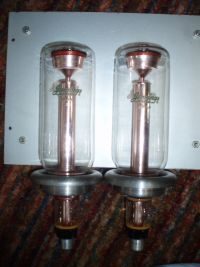

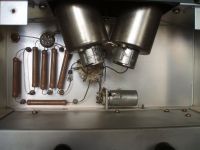
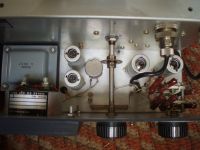
sparky99, Thu Jul 15 2010, 05:34PM
Here's some under the hood pictures:




Re: Can anyone help with info on this great find ??
sparky99, Thu Jul 15 2010, 05:35PM
And a few more:



sparky99, Thu Jul 15 2010, 05:35PM
And a few more:



Re: Can anyone help with info on this great find ??
sparky99, Thu Jul 15 2010, 05:41PM
In the bottom of the Vacuum cap sockets, there is a 800mmf 500 Volt doorknob cap in series with the vacuum cap. Coming up with a schematic for this is going to take a little time, the unit has 2, two wafer ceramic switches and the little wiring harness is laced.
I'm going to email Jennings and see if they can supply a manual / schematic for this unit.
Regards,
bob
sparky99, Thu Jul 15 2010, 05:41PM
In the bottom of the Vacuum cap sockets, there is a 800mmf 500 Volt doorknob cap in series with the vacuum cap. Coming up with a schematic for this is going to take a little time, the unit has 2, two wafer ceramic switches and the little wiring harness is laced.
I'm going to email Jennings and see if they can supply a manual / schematic for this unit.
Regards,
bob
Re: Can anyone help with info on this great find ??
radiotech, Thu Jul 15 2010, 07:59PM
If you can trace the heater wiring of the 6AL5, see if it is connected in series with any resistors 10 or 15 ohms on its way back to the transformer.
radiotech, Thu Jul 15 2010, 07:59PM
If you can trace the heater wiring of the 6AL5, see if it is connected in series with any resistors 10 or 15 ohms on its way back to the transformer.
Re: Can anyone help with info on this great find ??
Adam Munich, Thu Jul 15 2010, 10:30PM
Wow, forget the vacuum caps, that diode is a much bigger X-ray hazard!
Also, as i posted before, if the glass is heavier than it should be, it may be leaded.
Adam Munich, Thu Jul 15 2010, 10:30PM
Wow, forget the vacuum caps, that diode is a much bigger X-ray hazard!
Also, as i posted before, if the glass is heavier than it should be, it may be leaded.
Re: Can anyone help with info on this great find ??
IntraWinding, Fri Jul 16 2010, 02:42AM
But a 1/2" is only about double the gap in the vacuum capacitors, so I think it could make a big difference. And any corona leakage could screw with the measured voltage too. Anyway, I guess once you have a stable voltage to measure it's easy enough to try it and see..
IntraWinding, Fri Jul 16 2010, 02:42AM
Grenadier wrote ...
I doubt any parasitic capacitance from lead .5" away still separated by the glass tube would be significant.
I doubt any parasitic capacitance from lead .5" away still separated by the glass tube would be significant.
But a 1/2" is only about double the gap in the vacuum capacitors, so I think it could make a big difference. And any corona leakage could screw with the measured voltage too. Anyway, I guess once you have a stable voltage to measure it's easy enough to try it and see..
Re: Can anyone help with info on this great find ??
Adam Munich, Fri Jul 16 2010, 03:20AM
^^ The cap gap only appears to be a few mm.
Adam Munich, Fri Jul 16 2010, 03:20AM
^^ The cap gap only appears to be a few mm.
Re: Can anyone help with info on this great find ??
klugesmith, Fri Jul 16 2010, 03:42AM
Why are so many people here looking for an x-ray hazard in ordinary vacuum capacitors? I did read the whole thread, but still stand with plazmatron in being relatively unconcerned.
X-ray production mechanisms and dose limits were well understood when Sparky's enviable instrument was made.
Field emission from smooth copper electrodes requires E-fields of about 1000 volts per micron.
Flash x-ray tubes have cold cathodes that are sharp points, working at over 100 kV.


[edit] and I wouldn't be surprised if Sparky's caps are rated for just 50 kV each, with the 100 kV range being only for differential mode.
klugesmith, Fri Jul 16 2010, 03:42AM
Why are so many people here looking for an x-ray hazard in ordinary vacuum capacitors? I did read the whole thread, but still stand with plazmatron in being relatively unconcerned.
X-ray production mechanisms and dose limits were well understood when Sparky's enviable instrument was made.
Field emission from smooth copper electrodes requires E-fields of about 1000 volts per micron.
Flash x-ray tubes have cold cathodes that are sharp points, working at over 100 kV.


[edit] and I wouldn't be surprised if Sparky's caps are rated for just 50 kV each, with the 100 kV range being only for differential mode.
Re: Can anyone help with info on this great find ??
Adam Munich, Fri Jul 16 2010, 03:59AM
What about the Diode? At 100kv, the sheet metal will do very little to stop x-rays. It's a heated cathode diode, and essentially a Coolidge tube at those voltages.
Unless his diode is biased with substantially lower voltages, however i really have no idea how it's hooked up. If it is passing the full voltage though, it is definitely a hazard.
Adam Munich, Fri Jul 16 2010, 03:59AM
What about the Diode? At 100kv, the sheet metal will do very little to stop x-rays. It's a heated cathode diode, and essentially a Coolidge tube at those voltages.
Unless his diode is biased with substantially lower voltages, however i really have no idea how it's hooked up. If it is passing the full voltage though, it is definitely a hazard.
Re: Can anyone help with info on this great find ??
klugesmith, Fri Jul 16 2010, 04:00AM
klugesmith, Fri Jul 16 2010, 04:00AM
Grenadier wrote ...
What about the Diode? At 100kv, the sheet metal will do very little to stop x-rays. It's a heated cathode diode, and essentially a Coolidge tube at those voltages.
Why would any voltages more than 1 kV ever appear below the glass vacuum capacitors? The instrument is a capacitive voltage divider like the one Patrick (?) had been designing.What about the Diode? At 100kv, the sheet metal will do very little to stop x-rays. It's a heated cathode diode, and essentially a Coolidge tube at those voltages.
Re: Can anyone help with info on this great find ??
Adam Munich, Fri Jul 16 2010, 04:02AM
Damn, you caught my ninja edit.
Alright then, good luck sparky! I'd still invest in a scintillator though.
Adam Munich, Fri Jul 16 2010, 04:02AM
Damn, you caught my ninja edit.
Alright then, good luck sparky! I'd still invest in a scintillator though.
Re: Can anyone help with info on this great find ??
OH7HJ, Sun Jun 12 2011, 06:32AM
Hi!
I would like to find a schematic for the Jennings J-1003 broadband AC high voltage meter, too, particularly to see how the 'unbal' mode of its selector is connected to further understand how it works.
The meter works very well - AC only, no DC with capacitive voltage dividers like this - and does not noticeably strain even those delicate microampere level circuits I regularly measure in about 20 kV electrostatic environment.
I clearly see that the 2.8 pF voltage dividing VDF-2.8 vacuum capacitor tubes consume practically no power from the measured circuits so they can not produce any measurable X-ray emissions, either.
The real challenge remains to find its schematic and manual! Here are some links to it but no manual or schematic there:



Regards,
- OH7HJ -
Finland
plasma.innoplaza.net
Here are some photos of the Jennings J-1003 high voltage AC meter I am using:

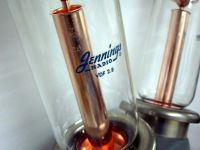
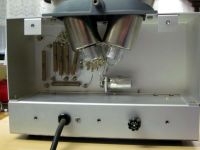

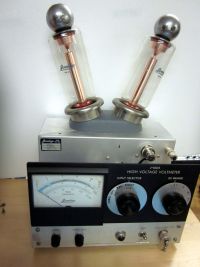
OH7HJ, Sun Jun 12 2011, 06:32AM
sparky99 wrote ...
Hi All,
... I sure would like to have a manual for it, but there is little online. Anyone have any info on this gem. A search of Jennings website turns up nothing...
Thanks,
bob
Hi All,
... I sure would like to have a manual for it, but there is little online. Anyone have any info on this gem. A search of Jennings website turns up nothing...
Thanks,
bob
Hi!
I would like to find a schematic for the Jennings J-1003 broadband AC high voltage meter, too, particularly to see how the 'unbal' mode of its selector is connected to further understand how it works.
The meter works very well - AC only, no DC with capacitive voltage dividers like this - and does not noticeably strain even those delicate microampere level circuits I regularly measure in about 20 kV electrostatic environment.
I clearly see that the 2.8 pF voltage dividing VDF-2.8 vacuum capacitor tubes consume practically no power from the measured circuits so they can not produce any measurable X-ray emissions, either.
The real challenge remains to find its schematic and manual! Here are some links to it but no manual or schematic there:




Regards,
- OH7HJ -
Finland
plasma.innoplaza.net

Here are some photos of the Jennings J-1003 high voltage AC meter I am using:





Re: Can anyone help with info on this great find ??
Carl Pugh, Sun Jun 12 2011, 05:27PM
MANY years ago Ross Engineering Corporation in Campbell CA made an identical voltmeter.
Mr. Hugh Ross would probably be willing to discuss the voltmeter if you gave him a phone call.
Carl Pugh, Sun Jun 12 2011, 05:27PM
MANY years ago Ross Engineering Corporation in Campbell CA made an identical voltmeter.
Mr. Hugh Ross would probably be willing to discuss the voltmeter if you gave him a phone call.
Print this page